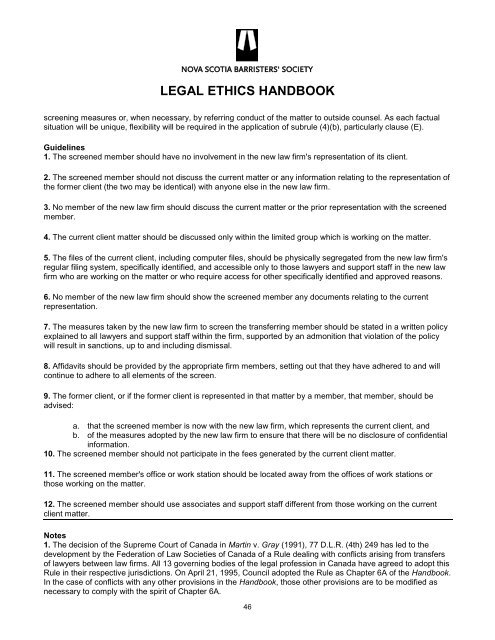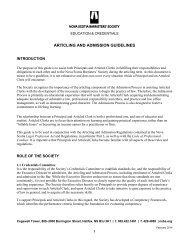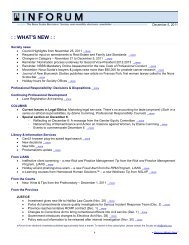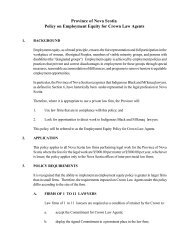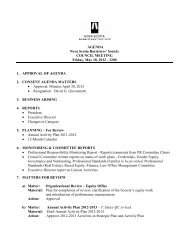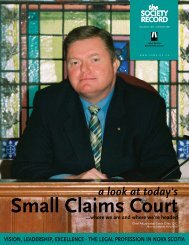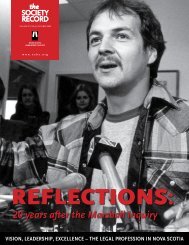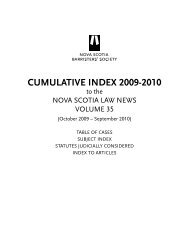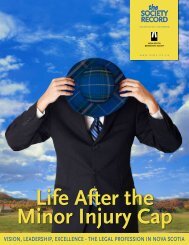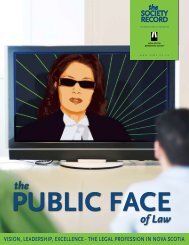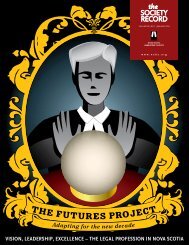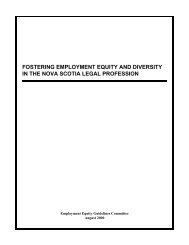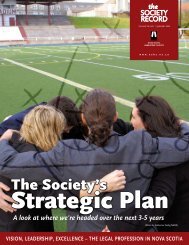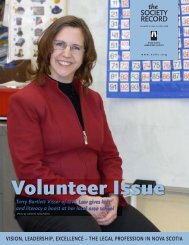legal ethics handbook - Nova Scotia Barristers' Society
legal ethics handbook - Nova Scotia Barristers' Society
legal ethics handbook - Nova Scotia Barristers' Society
You also want an ePaper? Increase the reach of your titles
YUMPU automatically turns print PDFs into web optimized ePapers that Google loves.
LEGAL ETHICS HANDBOOK<br />
screening measures or, when necessary, by referring conduct of the matter to outside counsel. As each factual<br />
situation will be unique, flexibility will be required in the application of subrule (4)(b), particularly clause (E).<br />
Guidelines<br />
1. The screened member should have no involvement in the new law firm's representation of its client.<br />
2. The screened member should not discuss the current matter or any information relating to the representation of<br />
the former client (the two may be identical) with anyone else in the new law firm.<br />
3. No member of the new law firm should discuss the current matter or the prior representation with the screened<br />
member.<br />
4. The current client matter should be discussed only within the limited group which is working on the matter.<br />
5. The files of the current client, including computer files, should be physically segregated from the new law firm's<br />
regular filing system, specifically identified, and accessible only to those lawyers and support staff in the new law<br />
firm who are working on the matter or who require access for other specifically identified and approved reasons.<br />
6. No member of the new law firm should show the screened member any documents relating to the current<br />
representation.<br />
7. The measures taken by the new law firm to screen the transferring member should be stated in a written policy<br />
explained to all lawyers and support staff within the firm, supported by an admonition that violation of the policy<br />
will result in sanctions, up to and including dismissal.<br />
8. Affidavits should be provided by the appropriate firm members, setting out that they have adhered to and will<br />
continue to adhere to all elements of the screen.<br />
9. The former client, or if the former client is represented in that matter by a member, that member, should be<br />
advised:<br />
a. that the screened member is now with the new law firm, which represents the current client, and<br />
b. of the measures adopted by the new law firm to ensure that there will be no disclosure of confidential<br />
information.<br />
10. The screened member should not participate in the fees generated by the current client matter.<br />
11. The screened member's office or work station should be located away from the offices of work stations or<br />
those working on the matter.<br />
12. The screened member should use associates and support staff different from those working on the current<br />
client matter.<br />
Notes<br />
1. The decision of the Supreme Court of Canada in Martin v. Gray (1991), 77 D.L.R. (4th) 249 has led to the<br />
development by the Federation of Law Societies of Canada of a Rule dealing with conflicts arising from transfers<br />
of lawyers between law firms. All 13 governing bodies of the <strong>legal</strong> profession in Canada have agreed to adopt this<br />
Rule in their respective jurisdictions. On April 21, 1995, Council adopted the Rule as Chapter 6A of the Handbook.<br />
In the case of conflicts with any other provisions in the Handbook, those other provisions are to be modified as<br />
necessary to comply with the spirit of Chapter 6A.<br />
46


